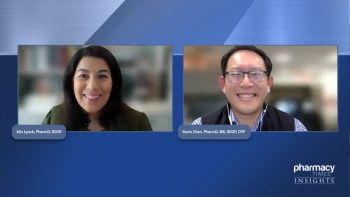
Risk Stratification in Patients with Multiple Myeloma
Ryan Haumschild, PharmD, MS, MBA, leads a discussion surrounding relapsed/refractory multiple myeloma (MM).
Episodes in this series

Ryan Haumschild, PharmD, MS, MBA: Hello, and welcome to this Pharmacy Times® Peer Exchange titled “Evolving Treatment Landscape and Relapsed/Refractory Multiple Myeloma.” My name is Dr Ryan Haumschild. I’m the director of pharmacy services at Emory Healthcare and the Winship Cancer Institute in Atlanta, Georgia. Joining me in this discussion are Kirollos Hanna, an oncology pharmacy manager at M Health Fairview Clinics and Surgery Center in Maple Grove Minnesota and an assistant professor of pharmacy at the Mayo Clinic College of Medicine in Minneapolis, Minnesota; Kathryn Maples, a clinical pharmacy specialist at the Winship Cancer Institute of Emory University in Atlanta, Georgia; Amir Ali, a hematology-oncology pharmacist at the Keck School of Medicine of USC [the University of Southern California] and the USC Norris Comprehensive Cancer Center in Los Angeles, California; and Shahrier Hossain, a clinical pharmacy specialist at Dana-Farber Cancer Institute in Boston, Massachusetts.
We’re going to talk about several topics pertaining to relapsed or refractory multiple myeloma, including discussions around the disease burden, cost of care, evolving treatment landscape, and most important, the role of the pharmacist. Let’s get started.
As we talk about multiple myeloma and the disease burden, it’s important that we give additional context. What is multiple myeloma? How do people become relapsed/refractory? Mr Hanna, I’ll turn to you. In the context of multiple myeloma, what is the risk? How are patients stratified by risk? Define a patient with a high-risk multiple myeloma. How do you treat patients with high risk?
Kirollos S. Hanna, PharmD, BCPS, BCOP: Thank you, Mr Haumschild. Those are excellent questions. When you look at the paradigm of multiple myeloma, for the past several decades, outside triplet regimens, we haven’t had many therapeutic options to treat these patients. But when you look at the past 5 to 6 years, things have exploded in the treatment options for these patients. When I was finishing residency, daratumumab and elotuzumab were novel therapeutics getting approved in 2015 and 2016. These were in the relapsed/refractory setting. Now we’re using daratumumab in frontline patients in a quadruplet drug regimen. There are a couple of things that we have to look at up front for our patients with myeloma.
One key thing that we always ask ourselves is whether our patients are transplant eligible or transplant ineligible. That’s going to dictate a lot of our therapeutic options and approaches. Oftentimes, that may have to do with their frailty and how young that patient is. But there are also risk factors that may put that patient at a higher risk vs another patient. When you look the guidelines, they talk about some of the risk factors associated with people with high-risk disease. These are the people you’re going to be thinking about transplanting, utilizing 4-drug regimens, and as we’ll mention throughout our discussion, using daratumumab-containing regimens. Some of the cytogenetics we look at are t(4;14), t(14;16), and deletion 17p. There’s also something called 1q gain or 1q amplifications. A lot of these cytogenetics may be associated with poor prognosis in these patients.
There are a lot of other things. There’s TP53 mutation or deletion 17p. We have MYC rearrangements or translocations, which are sometimes associated with high- or poor-risk disease or poor prognosis. We also have things associated with the manifestation of the disease, in terms of symptoms that can help us identify patients with high-risk disease. These can include thrombocytopenia and renal impairment. Obviously, if you have someone with renal impairment, 1 of the cornerstone therapeutic classes that we utilize are IMiDs [immunomodulatory imide drugs]. Lenalidomide is 1 of the frontline treatments, but in the presence of renal compromise, lenalidomide could be limited in terms of utility. We have elevated LDH [lactate dehydrogenase] and high serum free light chain ratios, and those are also associated with poor-risk characteristics in many patients. It’s recommended that you conduct some type of FISH [fluorescence in situ hybridization] studies, whether it’s on their bone marrow or whatever you’re analyzing, to evaluate patients and the translocations they have.
Ryan Haumschild, PharmD, MS, MBA: You did a great job highlighting the uniqueness of treating these patients. There isn’t 1 treatment that fits all patients. As you said, cytogenetics play a huge role, and so does some of the translocation in terms of what therapy you’d prefer by patient risk and whether they’re transplant eligible.
Transript edited for clarity.
Newsletter
Stay informed on drug updates, treatment guidelines, and pharmacy practice trends—subscribe to Pharmacy Times for weekly clinical insights.











































































































































































































